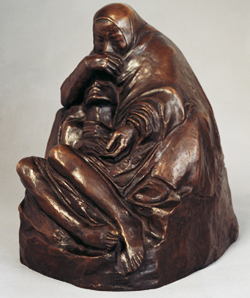
On December 7, the students in the Berlin: Experiment in Modernity course visited the Käthe Kollwitz Museum as part of their then on-going class discussion about social democracy, through the lens of Europe’s workers’ movement in the 19th and 20th century.
Situated in Berlin’s elegant Charlottenburg-Wilmersdorf neighborhood, the museum is actually a modified 19th century villa which houses art dealer Hans Pels-Leusden’s collection of over 200 prints, lithographs, drawings, woodcuts and sculptures by Kollwitz. Deviating from the conventional grand confinements of modern museums, the unique and cozy setting of the Käthe Kollwitz Museum helps to draw one’s attention to the harrowing human story behind the artist’s work and life.
Käthe Kollwitz (1967-1945) focused on an Expressionist portrayal of the human condition and character, under the dark grasp of poverty and inevitable death. In many ways, her art mirrored the tragedies of her own life. Having lived in the then working-class district of Prenzlauer Berg (neighboring ECLA of Bard’s Pankow) as the wife of a doctor, she herself saw and experienced the tragic tale that one can visually experience in her art. Her strong focus on human relationships, in particular the pain of being a suffering mother (“Mother with her Dead Son”), echoed her own tragedies: the death of her son, Peter, in Flanders in 1914 and of her grandson in World War II.
Additionally, her art strongly resonated with her political activism. For example, the poster “Nie wieder Krieg” (Never Again War) and her lithography “Brot” (Bread) express her socialist sympathies. It was for this reason that the rise of National Socialism led to her being expelled in 1933 from her post as Head of the Master Class for Graphic Arts at the Prussian Academy. After being banned from the museums and galleries of the Weimar Republic, Kollwitz’s self-portraits provide proof of her resistance as an artist, and of her humane tendency to rise above the darkness of suffering.
As I have also experienced with works by Goya, there is something about grotesque art that has a powerful inner effect. In retrospect, the museum visit, albeit depressing, drew me towards the human will to hope. After seeing the enlarged replica of Kollwitz’s “Mother with her Dead Son” at the Neue Wache on Unter den Linden, the original bronze cast struck me as too small (possibly containable within one cubic foot). Yet, there is something much more real in the works produced by Kollwitz. The hollow eyes, the longing hands, the darkness – they all evoke a sensation that is distant and yet familiar, and a fear with which we can all empathize to some extent.
Still, I felt a strange hope in knowing that, after having seen so much suffering, Kollwitz managed to trigger this empathy in today’s viewers. Perhaps art might be for art’s sake, but there is something positive about recognizing the grotesque side of emotions. The museum and the artworks made it clear that the suffering can be relatable as long as it is not grand and as long as it is humble enough to be understood.
